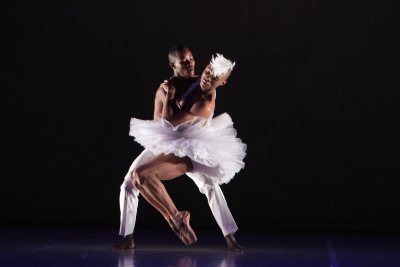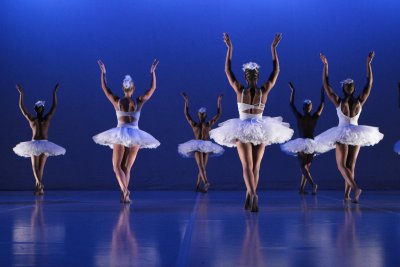Dada Masilo’s Swan Lake
A fascinating, but flawed twist on an old classical ballet chestnut.

Songezo Mcilizeli as Siegfried and Dada Masilo as Odette in a scene from “Swan Lake” (Photo credit: John Hogg)
[avatar user=”Joel Benjamin” size=”96″ align=”left” ] Joel Benjamin, Critic[/avatar]The choreographer, Dada Masilo, a South African native, deserves praise for her clever and at times moving hybrid take on the classical ballet masterpiece Swan Lake. Frankly, it didn’t totally succeed. This Swan Lake was too often a muddle of not-quite-this-and-not-quite-that, with out-of-order bits and pieces of Tchaikovsky mixed with the music of other composers, but there were many admirable moments fueled by a fertile and brave imagination and an honest desire to take on subjects as diverse as classical ballet, South African culture, gender roles and homophobia.
In the course of a single hour, Ms. Masilo managed to tell the basic story of Swan Lake—albeit a reconfigured version in which the Prince, Siegfried (a wiry, stalwart Songezo Mcilizeli) wants to run off with a male Odile, the black swan (Thamsanqa Tshabalala, tall, languid and quite agile in his pointe shoes) rather than marry the female Odette (Ms. Masilo, combining strength and fragility in equal measure).
A Master of Ceremony played by an effervescent Nicola Haskins was both an outside observer and Siegfried’s bitchy mother. Ms. Masilo provided Ms. Haskins with a scripted running commentary which used witty observations to make fun of classical ballet—very much in the manner of the late, great Anna Russell whose delicious musical satires were hilariously on point. It seems that when described out loud, ballet movements and mime can really be funny (“seaweed arms,” anyone?)
When her corps de ballet paraded onto the stage in very formal lines, to the coda of the “Black Swan Pas de Deux,” the steps included a great deal of ballet style leaping about and posing. Then she added booty shaking, pounding feet, pulsating upper bodies, reminiscent of African dance forms. This uneasy combination of styles, which also included African tribal vocalizing, never quite coalesced into a style.
They wore white tutus and feathered bits on their heads—the men bare-chested, the women in white tops (all designed by a little army consisting of Ms. Masilo, Suzette le Sueur, Karabo Legoabe and Ann & Kirsten Bailes). The costumes took on personalities of their own, sometimes looking traditional and at others like wind-swept grass skirts. The floor-length black skirts worn at the end turned the cast into all too emotionally vulnerable humans.
As she took the audience through her quick-moving plot, the dancers became courtiers and swans, Siegfried’s parents (Ms. Haskins and a tall, charismatic Kyle Rossouw) and the rival romantic tempters, Odette (whom Siegfried’s parents are eager for him to marry) and Odile (with whom Siegfried falls madly in love). Tchaikovsky’s “White Swan Pas de Deux” and Odette’s second act solo music were repurposed to express Siegfried’s confusion, while Saint-Saëns’ “The Swan,” the score for the “Dying Swan,” quoted the original Fokine choreography while adding some modern dance fluidity.
In the end, Ms. Masilo couldn’t quite reconcile the constant shift between the comic and the dramatic, the comedic too often overpowering the darker elements. The starkness of the last scene, “Swanicide,” in which the entire cast wandered about bare-chested, wearing those black skirts, to Arvo Pärt’s hauntingly somber, but over-used, “Spiegel im Spiegel” slowly, but inexorably, became a stage full of dead bodies. Why they felt it necessary to extinguish their lives wasn’t fully explicated by Ms. Masilo’s scenario. Were they dying of shame because Siegfried loved a man? Mourning the loss of an heir to the kingdom? Or just emotionally done in?
Suzette le Sueur’s lighting design was at times exquisite, including a subtly used array of footlights and a starry backdrop.
Dada Masilo’s Swan Lake (February 2-7, 2016)
Joyce Theater, 175 Eighth Avenue, in Manhattan
For tickets, call 212-242-0800 or visit http://www.joyce.org
Running time: one hour without an intermission







Leave a comment